England floods: What is making them worse?
 Huw Evans picture agency
Huw Evans picture agencyAbout 500 homes have been flooded in Doncaster with more than 1,000 properties evacuated in areas hit by the rising waters, including the village of Fishlake where residents have complained about the lack of warnings.
So what are the factors that have made these floods so damaging, and are they a taste of what the future might bring? Environment correspondent Matt McGrath has been looking at the likely causes of the floods along the Don.
Do we know why Fishlake has had such large floods?
There are numerous factors at play, but in essence Fishlake has been caught in a pincer movement with two rivers, the Don and Ea Beck both bursting their banks into an area that was heavily sodden from rain over a period of weeks.
Making matters worse is the fact that Fishlake is built on what was once a boggy fenland, that was drained many years ago.
"Fishlake is on the edge of the Great Humberhead levels which was a massive fenland and huge peat bog until the 1700s," said Prof Ian Rotherham from Sheffield Hallam University.
"By 1900, almost the entirety had gone. We drained the landscape and we've built on it."
Where did all the water come from?
There was a dramatic and sustained downpour last week with South Yorkshire receiving the equivalent of a month of rain in just one day.
But the situation was made worse because, according to experts, there was nothing to slow down the flow of the water in the River Don.
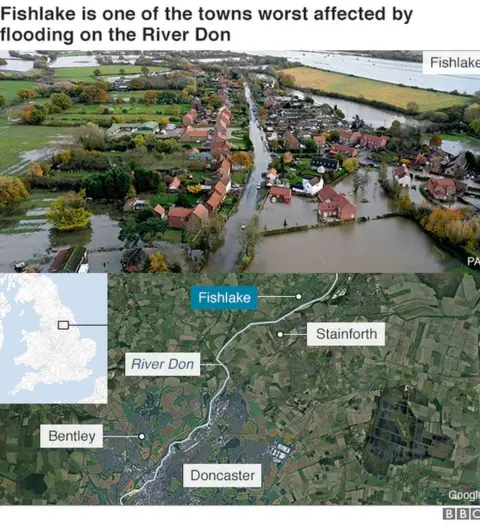
"This water is coming from the uplands, it is coming from the Peak District, from the Pennines," said Prof Rotherham.
"And what we have had there is the massive removal of peat by cutting, the burning of heather moorland and of course drainage, and instead of holding the water back in the uplands, it shoots downstream.
"All the way along we have straightened the rivers and drained the flood lands. The water rushes down. It is not being held back and it spews out across the lowlands and that's what happened here."
Have the flood defences installed in recent years simply moved the problem along?
There were severe floods in the Sheffield area back in 2007. Two people died and hundreds were evacuated.
In the aftermath, there were significant investments in new defences, with six protection schemes put in place around the city at a cost of £83m.
It involved the construction of more than 60 new flood protection measures along a five-mile stretch of the River Don.
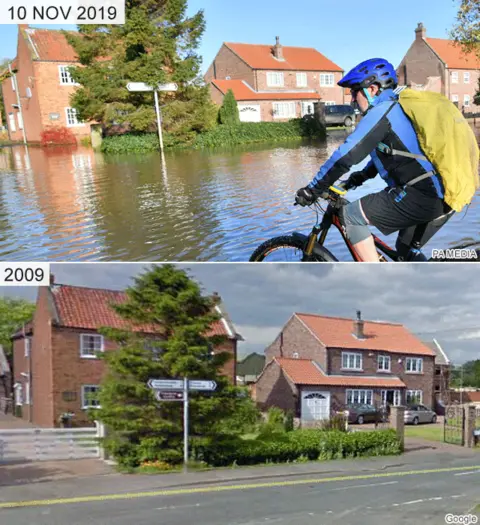 AFP
AFPThe Environment Agency said that these flood defences managed to significantly reduce the impact of last Thursday's inundation.
But defences can only go so far. Too often, severe floods will find the weakest point.
"In Sheffield, the main factories and other areas that were smashed back in 2007 are now protected," said Prof Rotherham.
"However, if you are keeping the water out of there, you are moving it faster downstream, and they get smashed even worse."
Are we protecting cities at the expense of the countryside?
The Environment Agency examine each flood protection scheme in the light of how it will benefit people and property. Rural areas aren't avoided, but urban areas generally need more protection.
"You might argue that's appropriate as there are more people and properties in urban areas, so it is not necessarily a bad thing," said Dr Liz Sharp from the University of Sheffield.
"If you accept it is going to rain more, and we don't have an infinite pot of money, then decisions need to be reached about what the priorities need to be."
Some flood experts say that rural areas are getting a raw deal at the moment.
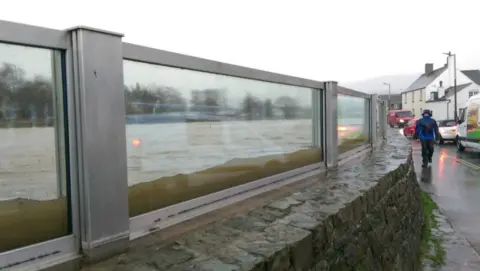 Environment Agency
Environment Agency"We don't have enough resources to protect all those people in rural areas and that really isn't good enough because those people are just as important as those who live in urban areas," said Prof Hannah Cloke, from the University of Reading.
"I think we need to prioritise everyone, we all have the same rights to be protected from floods wherever we live."
Is government funding for flooding having an impact?
The government say they are already investing £2.6bn over six years, in more than 1,000 projects to protect 300,000 homes from flooding and coastal erosion.
But the view among experts is that there simply isn't enough in the right places at the right time.
"There is a lack of resource in the Environment Agency and in the lead local flood authorities to undertake flood risk analysis and all the warning activities," said Prof Cloke.
"So they really are working on a shoestring in certain places. We've really got to sort out the funding so they are working together better. They are thinly staffed in places and that can be a problem in sorting out these issues."
Another challenge is that the funding seems to follow the areas that suffer disasters rather than going to the areas most in need.
"Somerset got a huge amount of publicity for flooding in 2013, but compare that to Hull in 2007 where 8,000 homes were inundated, and really the latter should have been the higher priority," said Dr Sharp.
"Attention should be given to where the needs are."
Would dredging the Don have helped?
Local residents in Fishlake say that their situation would have been improved if the Don had been dredged.
"It is a tidal river here, bringing in sand and silt from the Humber, and we have all the water coming off the hills around Sheffield," Fred Turner, 71, told the BBC.
"At high tides it is coming the other way too and Fishlake is in the middle."
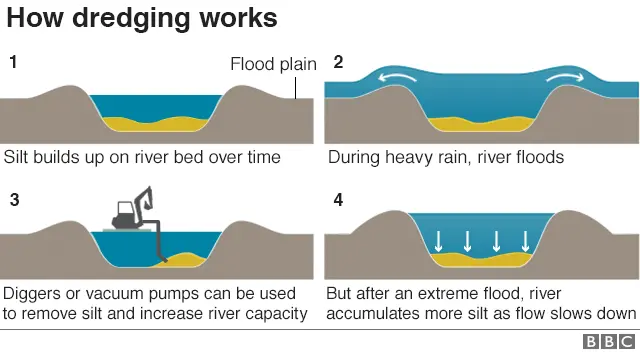
But many experts say that by itself dredging is not enough.
"It can be a good way of moving water from A to B," said Dr Liz Sharp from the University of Sheffield.
"But this may cause flooding at B, and this is the challenge with flood walls and dredging. They are just faster at conveying water, the more contemporary approach is to make space for the water."
Dr Sharp gives the example of the Rother Valley Park, where they have converted land that was once used for mining into a series of lakes that hold back more water when it rains and that has contributed to reducing flood threats in Doncaster.
Are there too many agencies involved?
The Environment Agency tends to look after the bigger rivers while there are dozens of internal drainage boards that have responsibility for managing water levels in areas across England. For smaller streams, local authorities usually have responsibility. All this means there is some potential for confusion.
"We have different authorities in charge of different parts of flooding and that can be a problem," said Prof Cloke.
"We have seen some steps forward since the flooding in 2007 with the Met Office and Environment Agency working much more closely together and that collaboration has been really valuable."
Were the warnings given in South Yorkshire adequate?
Local people in Fishlake have complained that they were told that their properties were safe hours before the water rushed in last week.
But forecasting the flow of water is very difficult indeed, especially when it gets down to local street level. Often you don't have just have one form of flooding such as a threat from rivers, you also have what's termed surface water flooding where rainwater is unable to drain away.
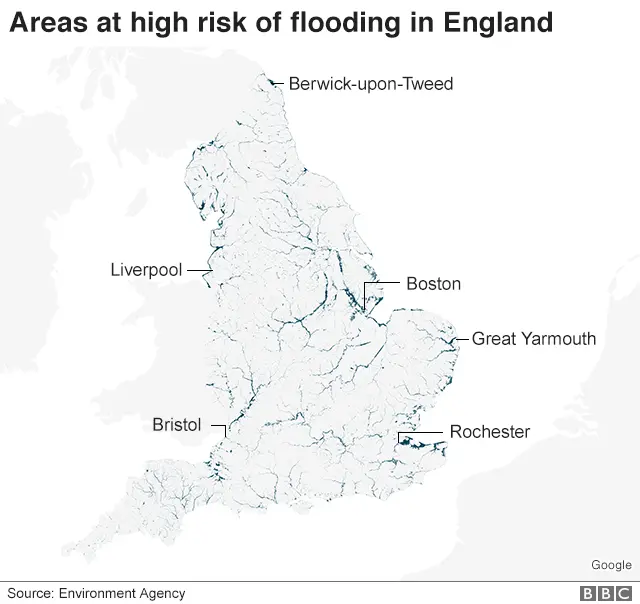
That type of flood often depends on how much rain is falling on a particular place and how much the land is able to absorb. In Fishlake and surrounding areas, there has been heavy rain for weeks, leading to sodden ground.
Is climate change likely to overwhelm even the best defences?
The physical facts of a warming world mean that the air can now hold more moisture. This means that downpours are heavier and likely to cause more flooding.
According to the UK Met Office, the amount of rain from extremely wet days in the UK has increased by 17% in the most recent decade (2008-2017) compared to 1961-1990.
There are things we can do to ensure that we adapt to cope with changes we are now seeing.
"We can have earlier warnings to get people out of the way, so they know what to do to protect their homes and businesses," said Hannah Cloke.
"We can retro-fit houses so they are more resilient to floods, and if we have to build on the flood plain, if there is nowhere else to build, then we can do it cleverly - by building on stilts and making those properties safe to live in."
Is what we've seen in Yorkshire a vision of the future?
"Yes it is a foretaste of the future," said Dr Liz Sharp.
"It will happen in different places, we need to be expecting this to happen more often."
Other experts agree that the future environment will be a challenge.
"We're running behind with climate change - we need to really speed up if we are going to keep on top of the problems that are being exacerbated by the change in the climate," said Prof Cloke.
"We don't really have the right infrastructure in place for the next 25 years to 50 years and that is very frightening."
Follow Matt on Twitter.
